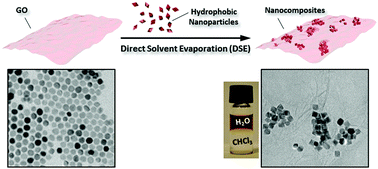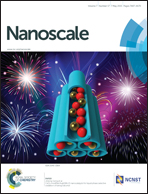Engineered water-soluble two-dimensional magnetic nanocomposites: towards highly magnetic relaxometric properties†
Abstract
Water dispersible two-dimensional magnetic nanocomposites are formed by phase-transferring hydrophobic manganese-doped ferrite nanoparticles (MFPs) into aqueous solvent using a one-step simple approach involving only graphene oxide (GO) as the phase transfer agent. The resultant hydrophilic magnetic nanocomposites (MFNs) are surprisingly stable in the aqueous phase despite its large hydrodynamic size (dhyd). Because of its unique construct that promotes water accessibility towards the MFP core, large MFNs loaded with an 18 nm MFP core (MFN-18; dhyd = 577.9 nm) exhibits transverse relaxivity (r2) up to ∼6.8 times (r2 = 800.8 mM [Mn + Fe]−1 s−1) higher than the typical individually coated MFP-18 with amphiphilic brush copolymers (r2 = 117.3 mM [Mn + Fe]−1 s−1). Meanwhile, the overall nanocomposites dhyd can be further reduced by employing a smaller pre-sonicated GO sheet phase transfer agent. As a result of using small GO sheets with enhanced hydrophilicity, the r2 of small MFN-18* nanocomposites (dhyd = 224.9 nm) increases by approximately 37% (r2 = 1097.4 mM [Mn + Fe]−1 s−1) as compared to larger MFN-18. From a simple comparative study among various magnetic nanocomposites involving a MFP-18 core, the high MFN-18 r2 relaxivity value can be attributed to enhanced water diffusion and exchange due to the GO sheet, allowing better interaction between magnetic the MFP core and water protons. The proposed method can be readily extended to convert other types of hydrophobic nanoparticles into water-dispersible nanocomposites.


 Please wait while we load your content...
Please wait while we load your content...